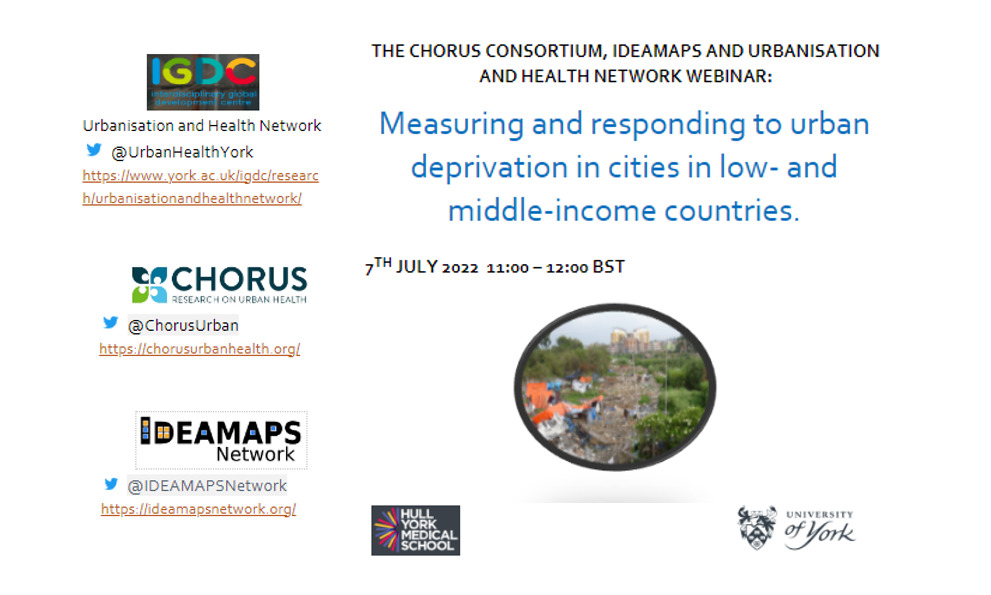
Blog: Measuring and Addressing Deprivation in Informal Settlements: Two Frameworks to Use
Delali Kumapley, Research Uptake Officer, CHORUS Ghana
In this blog, Delali Kumapley (CHORUS RU Officer) reports back on the recent webinar with CHORUS, IDEAMAPs, and the University of York’s Urbanisation and Health Network, on ‘Measuring and Responding to Urban Deprivation in Cities, in Low and Middle-Income Countries’, held on 7th July 22. The webinar showcased the IDEAMAPs’ Domains of Deprivation and UNHABITAT’s Participatory Slum Upgrading Programme, with Angela Abascal, Monika Kuffer, Dana Thompson (IDEAMAPs), and Joshua Maviti (UNHABITAT)
Several factors drive people into inner cities and most of the people living in informal settlements are not always captured by city governments and local actors, although their population keeps increasing, and unplanned and unmonitored growth creates areas of deprivation. Measuring the changes in slums and informal settlements is an enormous task but when frameworks are developed to quantify and address deprivation in such communities, they become an important tool that aids in the characterization and addressing issues related to health and development.
In a webinar that was organised in collaboration with the Integrated Deprived Area Mapping System (IDEAMAPs Network) and the UN-HABITAT Participatory Slum Upgrading Programme (PSUP), two different frameworks that could be used to measure deprivation and generate ideas about slum upgrading were discussed with the CHORUS team. This, among others, was to help the team in their research and subsequently, the co-creation process of interventions to help improve health in slum communities.
IDEAMAPS Network Domain of Deprivation
In their presentation, Angela Abascal and Monika Kuffer of IDEAMAPs stated that cities in lower-middle income countries (LMICs) faced unplanned growth of built areas resulting in deprived areas defined by slum conditions and informality.
The presenters noted that there are no accurate or scalable methods to understand what was happening in informal settlements instead, general frameworks were used in defining deprivation even in LMICs. Over time, there has also been a shift in deprivation studies which initially focused on high and middle-income countries.
Using existing literature on household and area-level deprivation frameworks, IDEAMAPS has developed a framework to better understand how urban deprivation is defined with a focus on cities in LMICs. The Domains of Deprivation Framework is designed to support diverse health, poverty, and development initiatives globally to characterize and address deprivation in LMIC cities, and facilitate a response to urban inequities.
The various domains found in the IDEAMAPS framework of deprivation include social hazards and assets, physical hazards and assets, unplanned urbanization, contamination, Socio-Economic Status (SES), housing, infrastructure, facilities and services and governance.

The process of developing the Domain of Deprivation included:
- A systematic review of the social science as well as the physical science literature to develop the first draft of the framework.
- The framework was presented at several workshops with representatives and groups of stakeholders from the community, local government, national government, local Civil Society Organisations etc.
- Additional domains were added and ways of categorizing these domains were improved based on the feedback of what was presented visually to make them more understandable and reusable.
The UN-HABITAT Participatory Slum Upgrading Index (PSUI)
Joshua Maviti (UNHABITAT PSUP) and Dana Thompson (UNHABITAT Consultant & IDEAMAPS Network Coordinator) discussed the Participatory Slum Upgrading Index. UN-HABITAT, in addressing deprivation in slum communities to help inner graded cities to prosper, have come up with activities that governments and local actors need to be doing.
The Participatory Slum Upgrade Index (PSUI) has the main role of decoding what can happen between programmes, policies, practices and slum upgrading of which participation has become a key measurement between governments and the people. The PSUI underscores and measures important values and practices of in situ participatory slum upgrading.
The PSUI also targets the interface of what the public needs/wants and what local government can provide. Using several indicators that measure both quality and quantity of participation, the PSUI, which is still being developed, will enable the monitoring of participatory slum upgrading within cities over time. The tool will be tested in 30 cities initially, and the findings will help develop the next iterations of the tool.

A great connection between these two frameworks are linkages between the physical or asset based measures of deprivation, and the social characteristics indicators, including the connectivity and holistic integration within the city.
The frameworks have important scope to help address the inequities and issues faced by poor urban residents, and will be valuable for the CHORUS teams as we move to the co-creation phase of the projects, working with the various stakeholders to design interventions to improve the health of the poorest urban residents. See the presentations here.